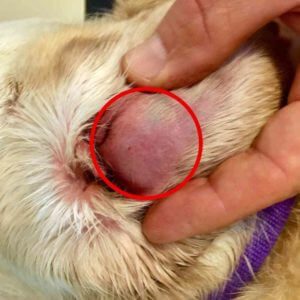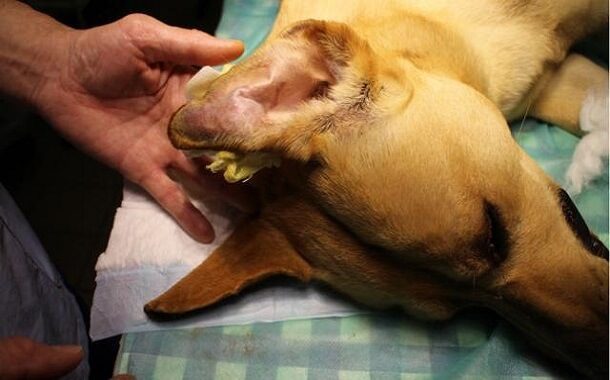How Much Does Dog Ear Hematoma Surgery Cost?
Last Updated on December 9, 2023
Written by CPA Alec Pow | Content Reviewed by ![]() CFA Alexander Popinker
CFA Alexander Popinker
A hematoma is a localized mass of blood that is confined to an organ or tissue. The most common type of hematoma in a dog is the one that affects the ear flap. This is called an othematoma.
The hematoma is surgically remedied, because most of the time the conservative treatment does not give results, and the othematoma recurs most of the time if it has not been surgically treated.
How Much Does Dog Ear Hematoma Surgery Cost?
The cost of ear hematoma surgery in dogs is anywhere between $320 and $2,100, depending on the geographical location, your vet, and the severity of the hematoma.
Mild hematomas may only require a single small incision. More swollen cauliflower-shaped hematomas need extensive deflating. Complex cases of aural hematomas run $1,000+.
A member of the Baby Center forum said that he was charged $1,100 by a clinic for draining and quilting his dog’s ear. Another member on the same forum said that he paid $500 to have his dog’s ear drained.
Also, some members of Reddit said that the average cost of a pet aural hematoma repair surgery would be around $550. Also, a dog owner said that his vet would recommend this surgery only if it is for a show-quality dog, purely for cosmetic reasons.
You might also like our articles on the cost of entropion surgery, lipoma removal, or tumor removal in dogs.
Surgery performed by a specialty veterinary surgeon tends to cost more than a general practice vet may charge, often $800+.
According to the Vetary website, the overall cost of ear hematoma surgery would be anywhere between $320 and $2,600, depending on the complexity of your dog’s condition and the local cost of living.
Details about ear hematoma surgery for dogs
The hematoma should be treated as soon as possible to avoid permanent disfigurement.
The recommended method of treatment is the surgical correction of the hematoma. The actual surgical technique varies depending on the individual circumstances and the preferences of the veterinarian but always involves the same basic steps, like making a small incision in the ear flap.
First, the skin over the hematoma is surgically incised to drain the blood and remove any blood clots. The space (called the dead space) is then removed by placing numerous sutures through the ear, which will promote the controlled formation of scar tissue, reattaching the cartilage to the skin and helping to prevent future recurrence. A drainage channel can be placed to facilitate drainage. It can be supported by a bandage or other material applied directly to the ear or through a headband.
In addition to treating hematoma, it is important to treat the root cause, which in many cases is an infection or allergy. Dogs with long ears are more prone to ear infections. Once the hematoma has been surgically corrected, if an underlying cause of the ear problem is found, such as an infection, allergy, or foreign body, it will be treated.
What are the extra costs?
Not all vet clinics have the same billing practices. Some of them will add all the costs in one bill, while others may charge separately for anesthesia, follow-up visits, pain medication, and extra laboratory testing. Make sure you ask about what is included in your final bill. Count on $60+ here.
Fluid and tissue samples generally are sent for pathology testing to ensure underlying conditions weren’t missed which adds another $150+.
Symptoms of ear hematoma in dogs
 Dog ear hematoma occurs when a blood vessel in the ear bursts and bleeds in the space between the ear cartilage and the skin. This is most commonly associated with trauma, such as scratching, shaking of the ears, or the bite of wounds.
Dog ear hematoma occurs when a blood vessel in the ear bursts and bleeds in the space between the ear cartilage and the skin. This is most commonly associated with trauma, such as scratching, shaking of the ears, or the bite of wounds.
Dogs with ear infections can shake their heads violently or scratch their ears causing a hematoma. In some cases, there may be a piece of foreign material deposited in the dog’s ear canal, such as a tick, a piece of grass, or even ear mites.
Long-eared dogs are at higher risk of developing ear hematoma. Pets with clotting or bleeding disorders may also develop hematomas with or without a history of trauma.
Drainage can lead to a temporary correction, but in most cases, the ear hematoma may return within one to two days. The more the hematoma is left untreated, the greater the likelihood of permanent damage and disfigurement. Treating ear hematomas in dogs through drainage can be used if the hematoma is very small or if the dog cannot undergo surgery for some reason.
Will the dog’s ear hematoma disappear over time, just like a bruise, without medical intervention?
If left untreated, the hematoma can be slowly reabsorbed, but the associated inflammation will affect the ear tissues, resulting in a distorted, “cauliflower ear”. Dog ear hematomas are very painful and should be evaluated and treated immediately.
Does pet insurance cover ear hematoma surgery in dogs?
Pet insurance will cover a portion of cat and dog aural hematoma repair surgery, but policy limits, deductibles, or other restrictions may apply.
If the dog’s ear hematoma existed before enrollment in the policy, it would likely be excluded as a pre-existing condition.
Like most surgeries, the annual deductible would need to be met first before reimbursements are issued. Deductibles often range from $100 to $500+.
There may be a maximum claim payout per condition (often $2,000 or more), and sometimes for ear issues specifically. Related medications or lab testing costs also apply here.
The coinsurance percentage means that pet owners pay a portion of costs (10-30% often). So for a $500 surgery, the pet parent may pay $50-150 or more out of pocket.
How can I save money?
There is a cheaper alternative to the dog ear hematoma surgery, namely the aspiration of the blood from the dog’s ear. However, in some situations, only one session may not be enough and more vet visits will be necessary throughout time.


Leave a Reply
Want to join the discussion?Feel free to contribute!